Analyzing HRM's Impact on Driving Organizational Performance
VerifiedAdded on 2020/05/28
|11
|2145
|42
Report
AI Summary
This report delves into the significant role of the Human Resource Management (HRM) department in driving and sustaining organizational performance. It emphasizes that effective HRM is crucial for business success in a competitive market. The report highlights three key areas: recruitment, compensation strategies, and performance appraisal. The report explains how strategic HRM ensures the right employees are recruited and retained, the importance of effective compensation strategies in motivating employees, and the impact of performance appraisals on employee development and organizational effectiveness. It concludes that organizations must recognize the continuous changes in HRM to maximize productivity and achieve profitability. This report is a valuable resource for students seeking to understand the strategic importance of HRM.
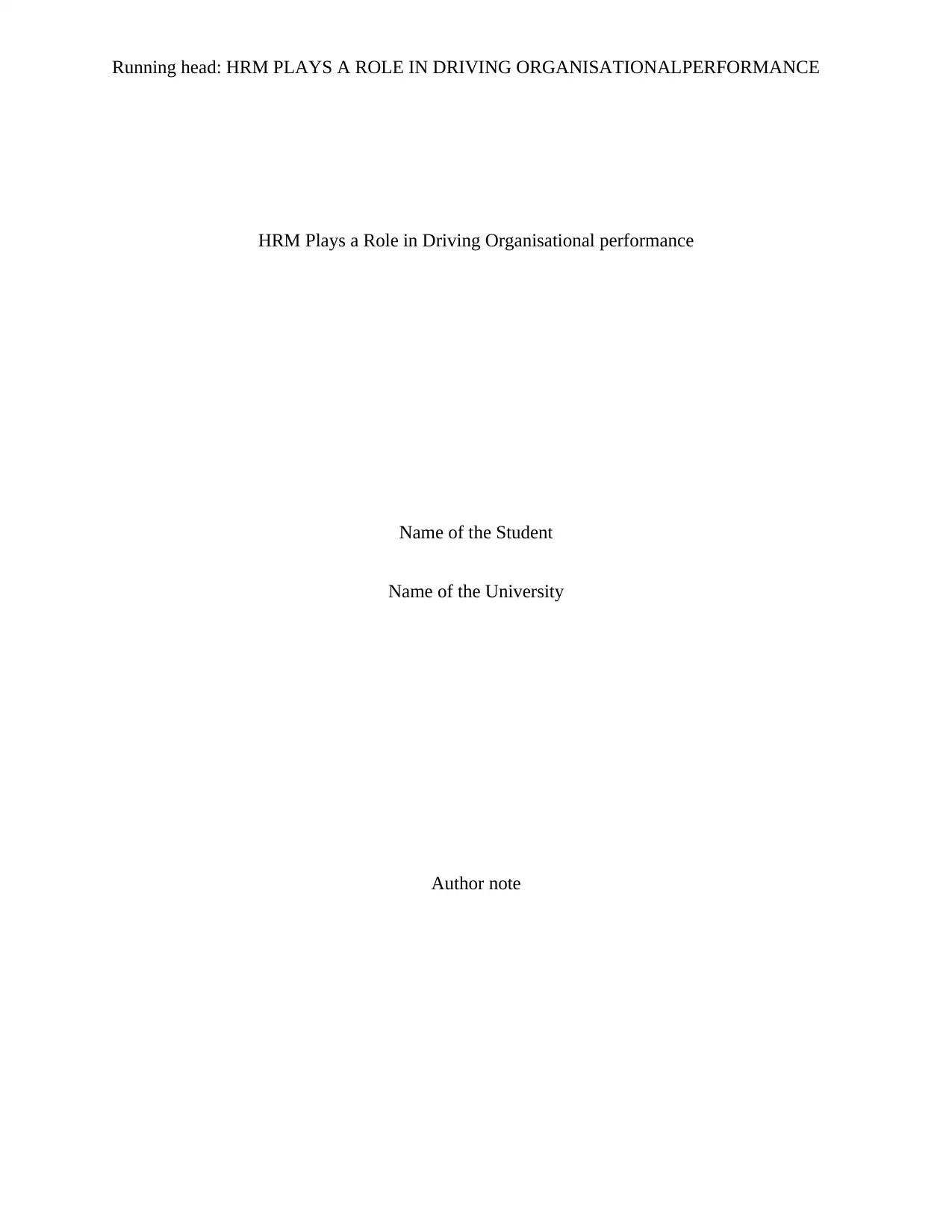
Running head: HRM PLAYS A ROLE IN DRIVING ORGANISATIONALPERFORMANCE
HRM Plays a Role in Driving Organisational performance
Name of the Student
Name of the University
Author note
HRM Plays a Role in Driving Organisational performance
Name of the Student
Name of the University
Author note
Paraphrase This Document
Need a fresh take? Get an instant paraphrase of this document with our AI Paraphraser
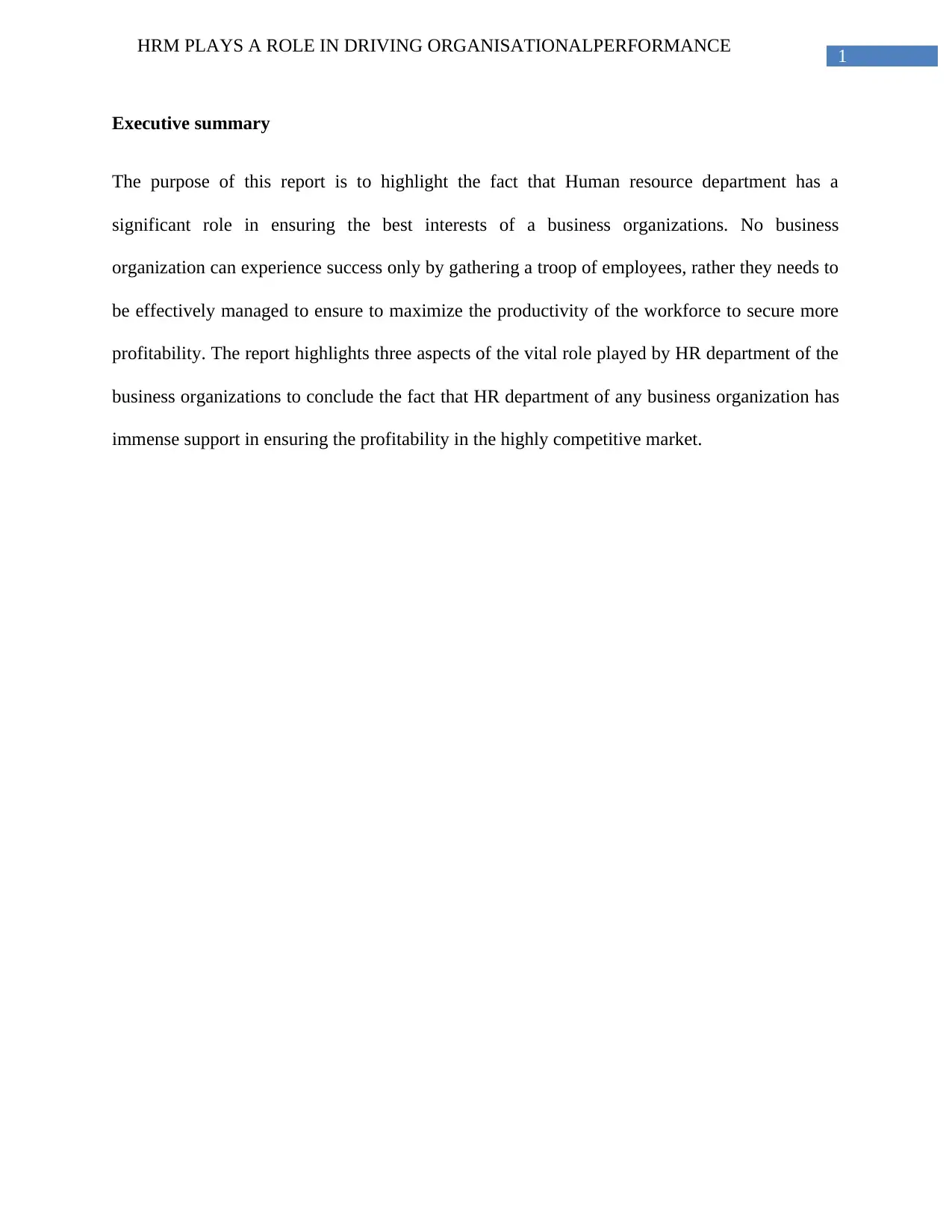
1
HRM PLAYS A ROLE IN DRIVING ORGANISATIONALPERFORMANCE
Executive summary
The purpose of this report is to highlight the fact that Human resource department has a
significant role in ensuring the best interests of a business organizations. No business
organization can experience success only by gathering a troop of employees, rather they needs to
be effectively managed to ensure to maximize the productivity of the workforce to secure more
profitability. The report highlights three aspects of the vital role played by HR department of the
business organizations to conclude the fact that HR department of any business organization has
immense support in ensuring the profitability in the highly competitive market.
HRM PLAYS A ROLE IN DRIVING ORGANISATIONALPERFORMANCE
Executive summary
The purpose of this report is to highlight the fact that Human resource department has a
significant role in ensuring the best interests of a business organizations. No business
organization can experience success only by gathering a troop of employees, rather they needs to
be effectively managed to ensure to maximize the productivity of the workforce to secure more
profitability. The report highlights three aspects of the vital role played by HR department of the
business organizations to conclude the fact that HR department of any business organization has
immense support in ensuring the profitability in the highly competitive market.
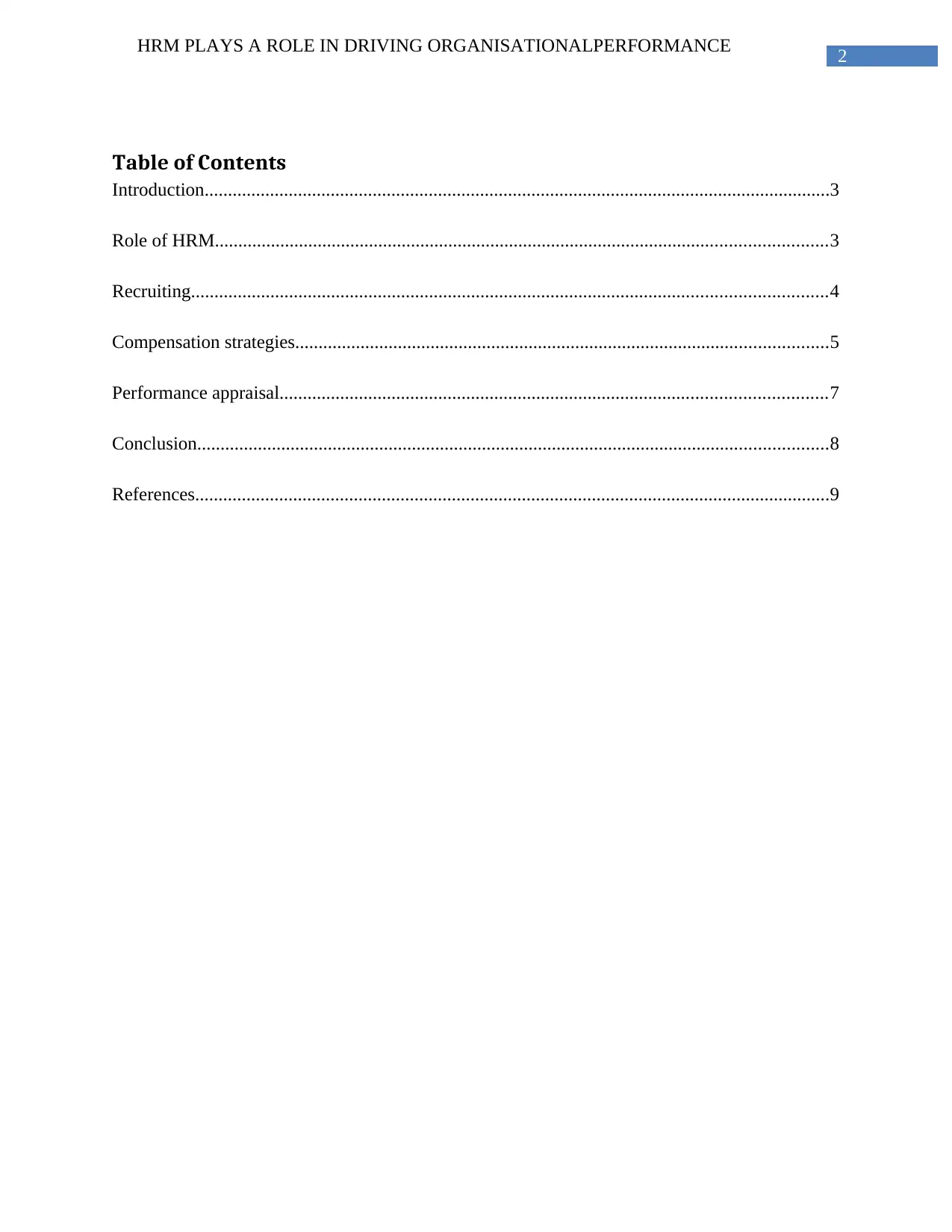
2
HRM PLAYS A ROLE IN DRIVING ORGANISATIONALPERFORMANCE
Table of Contents
Introduction......................................................................................................................................3
Role of HRM...................................................................................................................................3
Recruiting........................................................................................................................................4
Compensation strategies..................................................................................................................5
Performance appraisal.....................................................................................................................7
Conclusion.......................................................................................................................................8
References........................................................................................................................................9
HRM PLAYS A ROLE IN DRIVING ORGANISATIONALPERFORMANCE
Table of Contents
Introduction......................................................................................................................................3
Role of HRM...................................................................................................................................3
Recruiting........................................................................................................................................4
Compensation strategies..................................................................................................................5
Performance appraisal.....................................................................................................................7
Conclusion.......................................................................................................................................8
References........................................................................................................................................9
⊘ This is a preview!⊘
Do you want full access?
Subscribe today to unlock all pages.

Trusted by 1+ million students worldwide
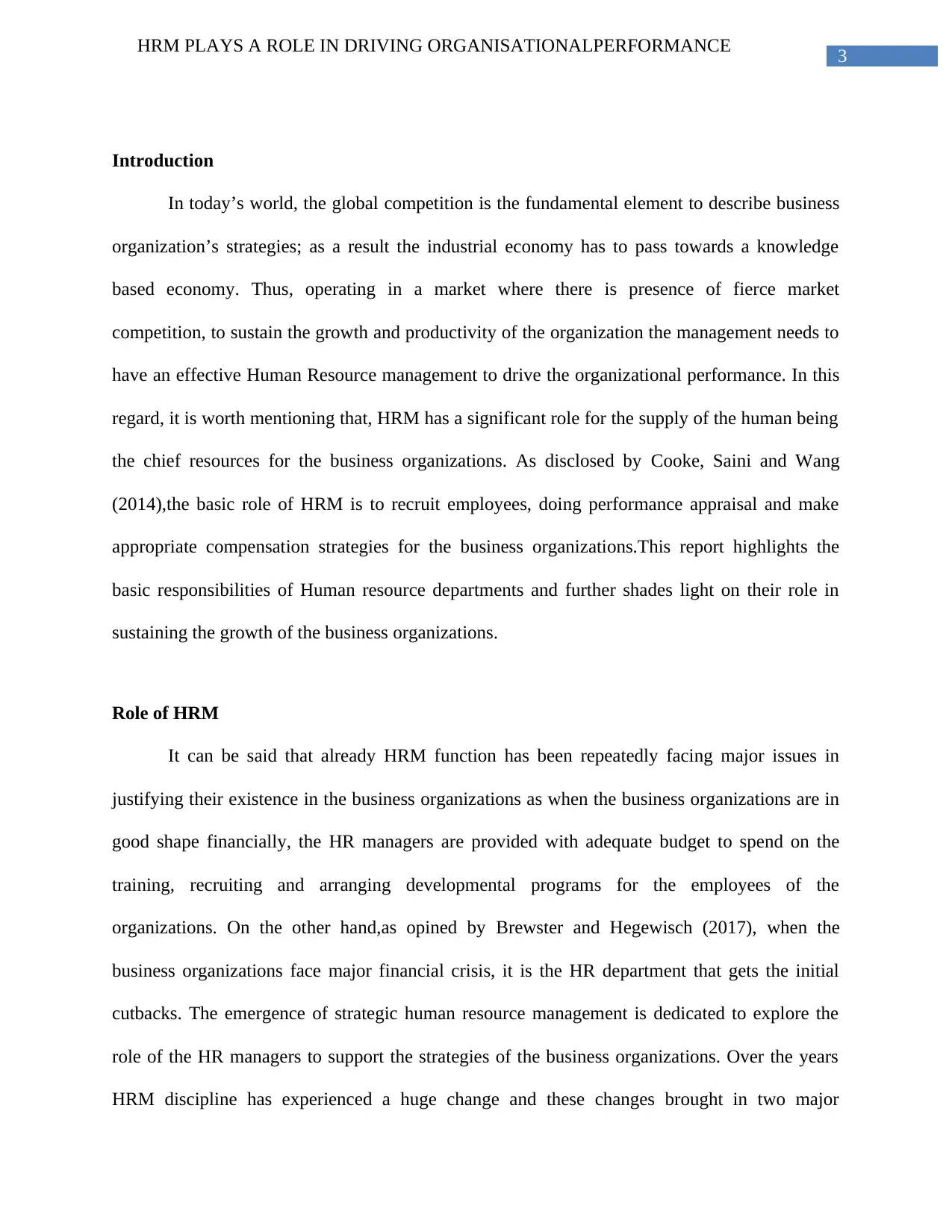
3
HRM PLAYS A ROLE IN DRIVING ORGANISATIONALPERFORMANCE
Introduction
In today’s world, the global competition is the fundamental element to describe business
organization’s strategies; as a result the industrial economy has to pass towards a knowledge
based economy. Thus, operating in a market where there is presence of fierce market
competition, to sustain the growth and productivity of the organization the management needs to
have an effective Human Resource management to drive the organizational performance. In this
regard, it is worth mentioning that, HRM has a significant role for the supply of the human being
the chief resources for the business organizations. As disclosed by Cooke, Saini and Wang
(2014),the basic role of HRM is to recruit employees, doing performance appraisal and make
appropriate compensation strategies for the business organizations.This report highlights the
basic responsibilities of Human resource departments and further shades light on their role in
sustaining the growth of the business organizations.
Role of HRM
It can be said that already HRM function has been repeatedly facing major issues in
justifying their existence in the business organizations as when the business organizations are in
good shape financially, the HR managers are provided with adequate budget to spend on the
training, recruiting and arranging developmental programs for the employees of the
organizations. On the other hand,as opined by Brewster and Hegewisch (2017), when the
business organizations face major financial crisis, it is the HR department that gets the initial
cutbacks. The emergence of strategic human resource management is dedicated to explore the
role of the HR managers to support the strategies of the business organizations. Over the years
HRM discipline has experienced a huge change and these changes brought in two major
HRM PLAYS A ROLE IN DRIVING ORGANISATIONALPERFORMANCE
Introduction
In today’s world, the global competition is the fundamental element to describe business
organization’s strategies; as a result the industrial economy has to pass towards a knowledge
based economy. Thus, operating in a market where there is presence of fierce market
competition, to sustain the growth and productivity of the organization the management needs to
have an effective Human Resource management to drive the organizational performance. In this
regard, it is worth mentioning that, HRM has a significant role for the supply of the human being
the chief resources for the business organizations. As disclosed by Cooke, Saini and Wang
(2014),the basic role of HRM is to recruit employees, doing performance appraisal and make
appropriate compensation strategies for the business organizations.This report highlights the
basic responsibilities of Human resource departments and further shades light on their role in
sustaining the growth of the business organizations.
Role of HRM
It can be said that already HRM function has been repeatedly facing major issues in
justifying their existence in the business organizations as when the business organizations are in
good shape financially, the HR managers are provided with adequate budget to spend on the
training, recruiting and arranging developmental programs for the employees of the
organizations. On the other hand,as opined by Brewster and Hegewisch (2017), when the
business organizations face major financial crisis, it is the HR department that gets the initial
cutbacks. The emergence of strategic human resource management is dedicated to explore the
role of the HR managers to support the strategies of the business organizations. Over the years
HRM discipline has experienced a huge change and these changes brought in two major
Paraphrase This Document
Need a fresh take? Get an instant paraphrase of this document with our AI Paraphraser
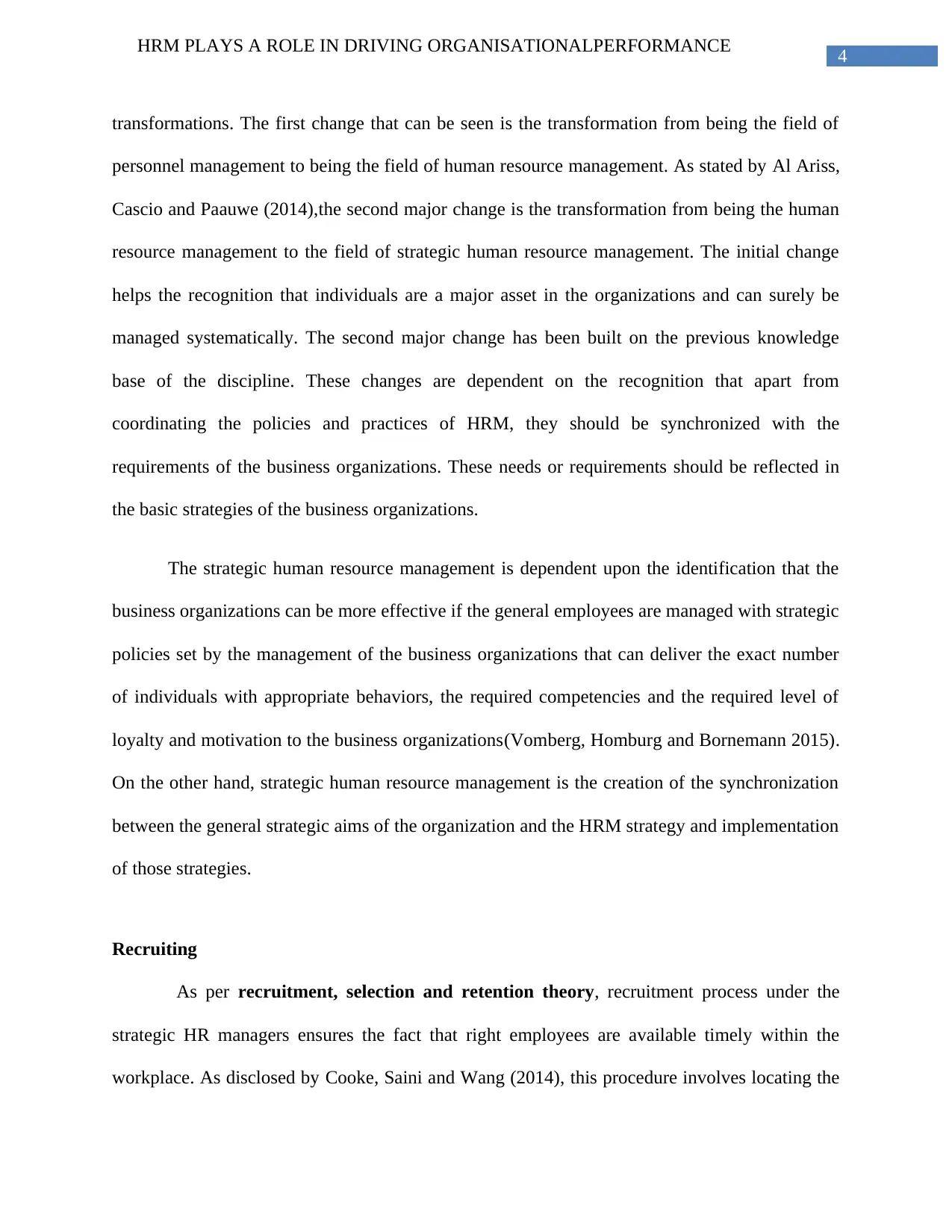
4
HRM PLAYS A ROLE IN DRIVING ORGANISATIONALPERFORMANCE
transformations. The first change that can be seen is the transformation from being the field of
personnel management to being the field of human resource management. As stated by Al Ariss,
Cascio and Paauwe (2014),the second major change is the transformation from being the human
resource management to the field of strategic human resource management. The initial change
helps the recognition that individuals are a major asset in the organizations and can surely be
managed systematically. The second major change has been built on the previous knowledge
base of the discipline. These changes are dependent on the recognition that apart from
coordinating the policies and practices of HRM, they should be synchronized with the
requirements of the business organizations. These needs or requirements should be reflected in
the basic strategies of the business organizations.
The strategic human resource management is dependent upon the identification that the
business organizations can be more effective if the general employees are managed with strategic
policies set by the management of the business organizations that can deliver the exact number
of individuals with appropriate behaviors, the required competencies and the required level of
loyalty and motivation to the business organizations(Vomberg, Homburg and Bornemann 2015).
On the other hand, strategic human resource management is the creation of the synchronization
between the general strategic aims of the organization and the HRM strategy and implementation
of those strategies.
Recruiting
As per recruitment, selection and retention theory, recruitment process under the
strategic HR managers ensures the fact that right employees are available timely within the
workplace. As disclosed by Cooke, Saini and Wang (2014), this procedure involves locating the
HRM PLAYS A ROLE IN DRIVING ORGANISATIONALPERFORMANCE
transformations. The first change that can be seen is the transformation from being the field of
personnel management to being the field of human resource management. As stated by Al Ariss,
Cascio and Paauwe (2014),the second major change is the transformation from being the human
resource management to the field of strategic human resource management. The initial change
helps the recognition that individuals are a major asset in the organizations and can surely be
managed systematically. The second major change has been built on the previous knowledge
base of the discipline. These changes are dependent on the recognition that apart from
coordinating the policies and practices of HRM, they should be synchronized with the
requirements of the business organizations. These needs or requirements should be reflected in
the basic strategies of the business organizations.
The strategic human resource management is dependent upon the identification that the
business organizations can be more effective if the general employees are managed with strategic
policies set by the management of the business organizations that can deliver the exact number
of individuals with appropriate behaviors, the required competencies and the required level of
loyalty and motivation to the business organizations(Vomberg, Homburg and Bornemann 2015).
On the other hand, strategic human resource management is the creation of the synchronization
between the general strategic aims of the organization and the HRM strategy and implementation
of those strategies.
Recruiting
As per recruitment, selection and retention theory, recruitment process under the
strategic HR managers ensures the fact that right employees are available timely within the
workplace. As disclosed by Cooke, Saini and Wang (2014), this procedure involves locating the
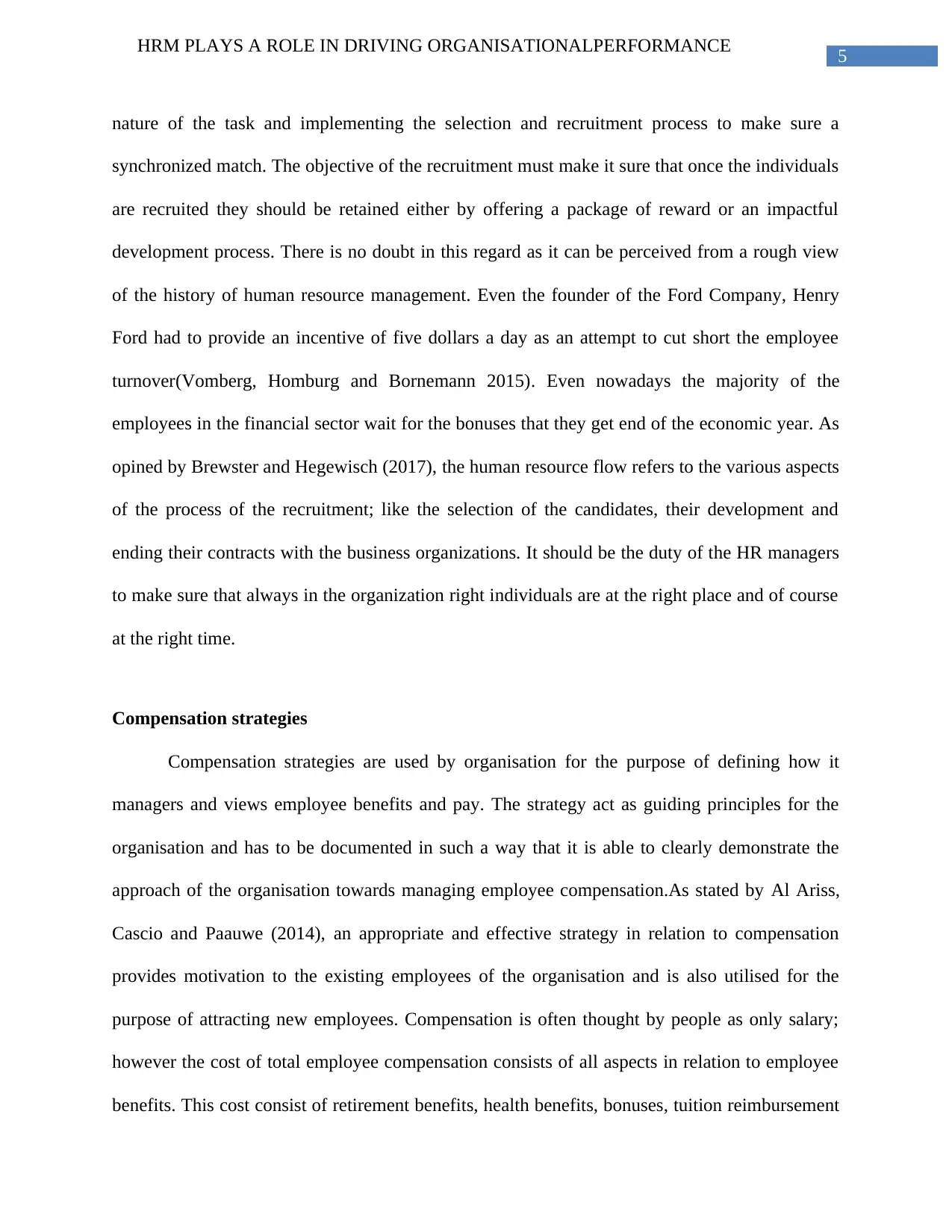
5
HRM PLAYS A ROLE IN DRIVING ORGANISATIONALPERFORMANCE
nature of the task and implementing the selection and recruitment process to make sure a
synchronized match. The objective of the recruitment must make it sure that once the individuals
are recruited they should be retained either by offering a package of reward or an impactful
development process. There is no doubt in this regard as it can be perceived from a rough view
of the history of human resource management. Even the founder of the Ford Company, Henry
Ford had to provide an incentive of five dollars a day as an attempt to cut short the employee
turnover(Vomberg, Homburg and Bornemann 2015). Even nowadays the majority of the
employees in the financial sector wait for the bonuses that they get end of the economic year. As
opined by Brewster and Hegewisch (2017), the human resource flow refers to the various aspects
of the process of the recruitment; like the selection of the candidates, their development and
ending their contracts with the business organizations. It should be the duty of the HR managers
to make sure that always in the organization right individuals are at the right place and of course
at the right time.
Compensation strategies
Compensation strategies are used by organisation for the purpose of defining how it
managers and views employee benefits and pay. The strategy act as guiding principles for the
organisation and has to be documented in such a way that it is able to clearly demonstrate the
approach of the organisation towards managing employee compensation.As stated by Al Ariss,
Cascio and Paauwe (2014), an appropriate and effective strategy in relation to compensation
provides motivation to the existing employees of the organisation and is also utilised for the
purpose of attracting new employees. Compensation is often thought by people as only salary;
however the cost of total employee compensation consists of all aspects in relation to employee
benefits. This cost consist of retirement benefits, health benefits, bonuses, tuition reimbursement
HRM PLAYS A ROLE IN DRIVING ORGANISATIONALPERFORMANCE
nature of the task and implementing the selection and recruitment process to make sure a
synchronized match. The objective of the recruitment must make it sure that once the individuals
are recruited they should be retained either by offering a package of reward or an impactful
development process. There is no doubt in this regard as it can be perceived from a rough view
of the history of human resource management. Even the founder of the Ford Company, Henry
Ford had to provide an incentive of five dollars a day as an attempt to cut short the employee
turnover(Vomberg, Homburg and Bornemann 2015). Even nowadays the majority of the
employees in the financial sector wait for the bonuses that they get end of the economic year. As
opined by Brewster and Hegewisch (2017), the human resource flow refers to the various aspects
of the process of the recruitment; like the selection of the candidates, their development and
ending their contracts with the business organizations. It should be the duty of the HR managers
to make sure that always in the organization right individuals are at the right place and of course
at the right time.
Compensation strategies
Compensation strategies are used by organisation for the purpose of defining how it
managers and views employee benefits and pay. The strategy act as guiding principles for the
organisation and has to be documented in such a way that it is able to clearly demonstrate the
approach of the organisation towards managing employee compensation.As stated by Al Ariss,
Cascio and Paauwe (2014), an appropriate and effective strategy in relation to compensation
provides motivation to the existing employees of the organisation and is also utilised for the
purpose of attracting new employees. Compensation is often thought by people as only salary;
however the cost of total employee compensation consists of all aspects in relation to employee
benefits. This cost consist of retirement benefits, health benefits, bonuses, tuition reimbursement
⊘ This is a preview!⊘
Do you want full access?
Subscribe today to unlock all pages.

Trusted by 1+ million students worldwide
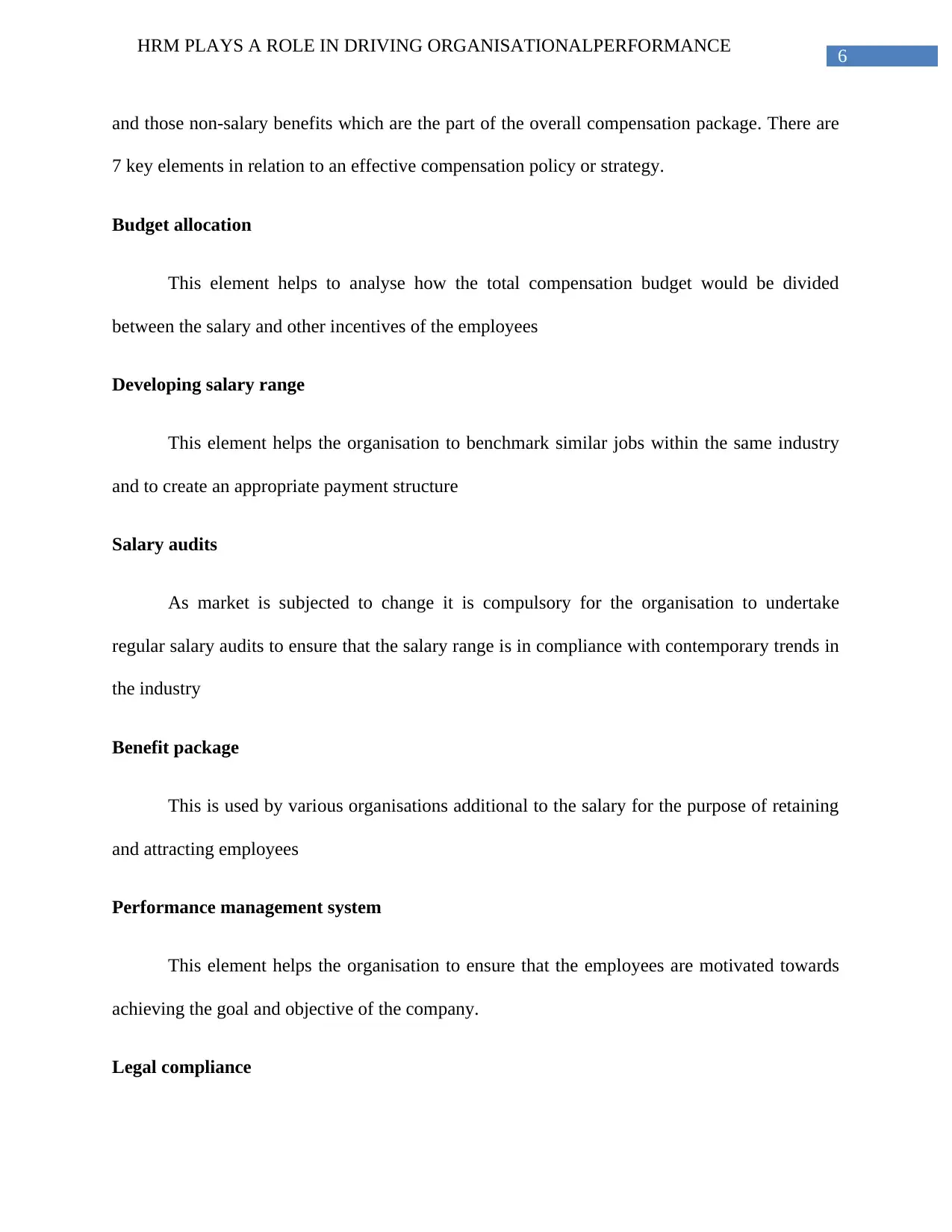
6
HRM PLAYS A ROLE IN DRIVING ORGANISATIONALPERFORMANCE
and those non-salary benefits which are the part of the overall compensation package. There are
7 key elements in relation to an effective compensation policy or strategy.
Budget allocation
This element helps to analyse how the total compensation budget would be divided
between the salary and other incentives of the employees
Developing salary range
This element helps the organisation to benchmark similar jobs within the same industry
and to create an appropriate payment structure
Salary audits
As market is subjected to change it is compulsory for the organisation to undertake
regular salary audits to ensure that the salary range is in compliance with contemporary trends in
the industry
Benefit package
This is used by various organisations additional to the salary for the purpose of retaining
and attracting employees
Performance management system
This element helps the organisation to ensure that the employees are motivated towards
achieving the goal and objective of the company.
Legal compliance
HRM PLAYS A ROLE IN DRIVING ORGANISATIONALPERFORMANCE
and those non-salary benefits which are the part of the overall compensation package. There are
7 key elements in relation to an effective compensation policy or strategy.
Budget allocation
This element helps to analyse how the total compensation budget would be divided
between the salary and other incentives of the employees
Developing salary range
This element helps the organisation to benchmark similar jobs within the same industry
and to create an appropriate payment structure
Salary audits
As market is subjected to change it is compulsory for the organisation to undertake
regular salary audits to ensure that the salary range is in compliance with contemporary trends in
the industry
Benefit package
This is used by various organisations additional to the salary for the purpose of retaining
and attracting employees
Performance management system
This element helps the organisation to ensure that the employees are motivated towards
achieving the goal and objective of the company.
Legal compliance
Paraphrase This Document
Need a fresh take? Get an instant paraphrase of this document with our AI Paraphraser
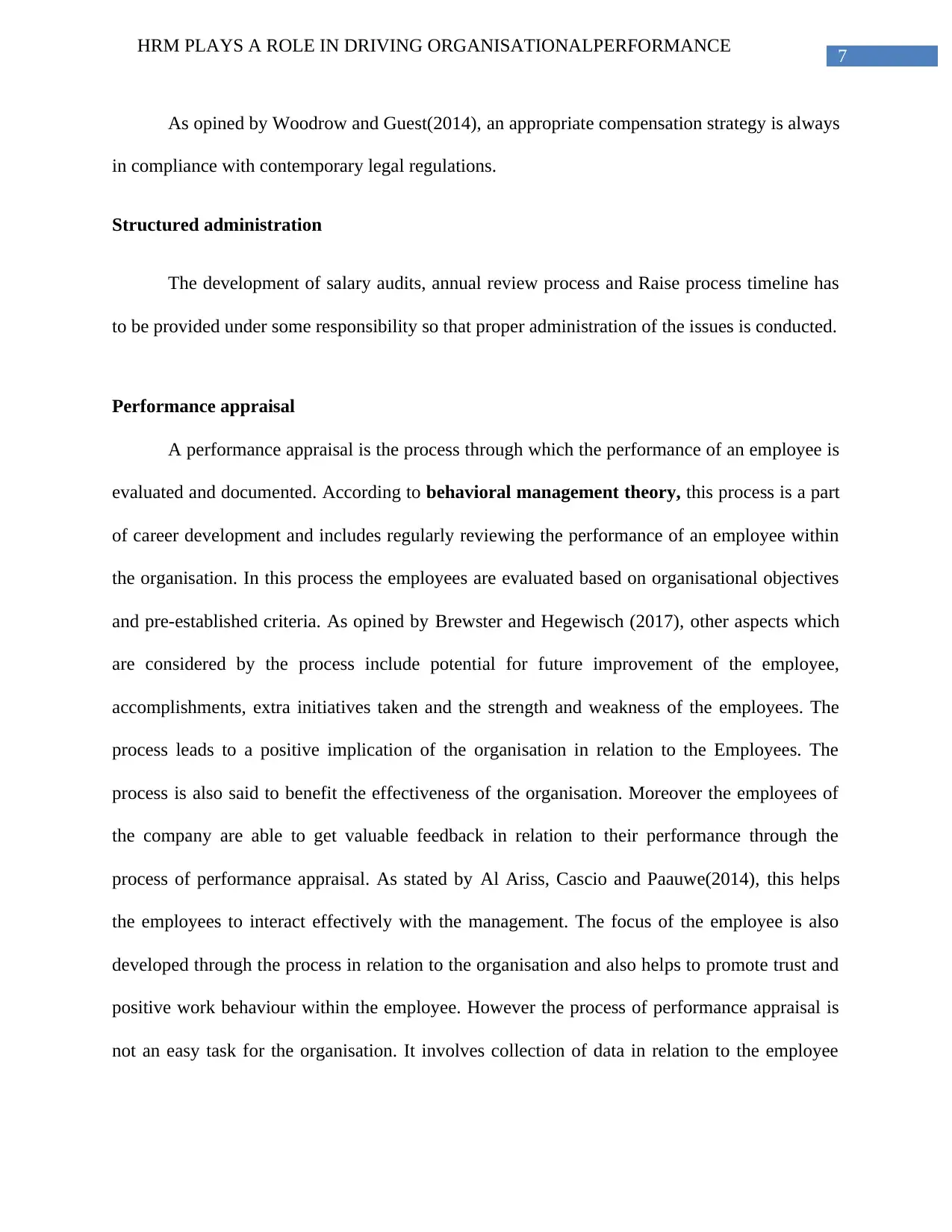
7
HRM PLAYS A ROLE IN DRIVING ORGANISATIONALPERFORMANCE
As opined by Woodrow and Guest(2014), an appropriate compensation strategy is always
in compliance with contemporary legal regulations.
Structured administration
The development of salary audits, annual review process and Raise process timeline has
to be provided under some responsibility so that proper administration of the issues is conducted.
Performance appraisal
A performance appraisal is the process through which the performance of an employee is
evaluated and documented. According to behavioral management theory, this process is a part
of career development and includes regularly reviewing the performance of an employee within
the organisation. In this process the employees are evaluated based on organisational objectives
and pre-established criteria. As opined by Brewster and Hegewisch (2017), other aspects which
are considered by the process include potential for future improvement of the employee,
accomplishments, extra initiatives taken and the strength and weakness of the employees. The
process leads to a positive implication of the organisation in relation to the Employees. The
process is also said to benefit the effectiveness of the organisation. Moreover the employees of
the company are able to get valuable feedback in relation to their performance through the
process of performance appraisal. As stated by Al Ariss, Cascio and Paauwe(2014), this helps
the employees to interact effectively with the management. The focus of the employee is also
developed through the process in relation to the organisation and also helps to promote trust and
positive work behaviour within the employee. However the process of performance appraisal is
not an easy task for the organisation. It involves collection of data in relation to the employee
HRM PLAYS A ROLE IN DRIVING ORGANISATIONALPERFORMANCE
As opined by Woodrow and Guest(2014), an appropriate compensation strategy is always
in compliance with contemporary legal regulations.
Structured administration
The development of salary audits, annual review process and Raise process timeline has
to be provided under some responsibility so that proper administration of the issues is conducted.
Performance appraisal
A performance appraisal is the process through which the performance of an employee is
evaluated and documented. According to behavioral management theory, this process is a part
of career development and includes regularly reviewing the performance of an employee within
the organisation. In this process the employees are evaluated based on organisational objectives
and pre-established criteria. As opined by Brewster and Hegewisch (2017), other aspects which
are considered by the process include potential for future improvement of the employee,
accomplishments, extra initiatives taken and the strength and weakness of the employees. The
process leads to a positive implication of the organisation in relation to the Employees. The
process is also said to benefit the effectiveness of the organisation. Moreover the employees of
the company are able to get valuable feedback in relation to their performance through the
process of performance appraisal. As stated by Al Ariss, Cascio and Paauwe(2014), this helps
the employees to interact effectively with the management. The focus of the employee is also
developed through the process in relation to the organisation and also helps to promote trust and
positive work behaviour within the employee. However the process of performance appraisal is
not an easy task for the organisation. It involves collection of data in relation to the employee
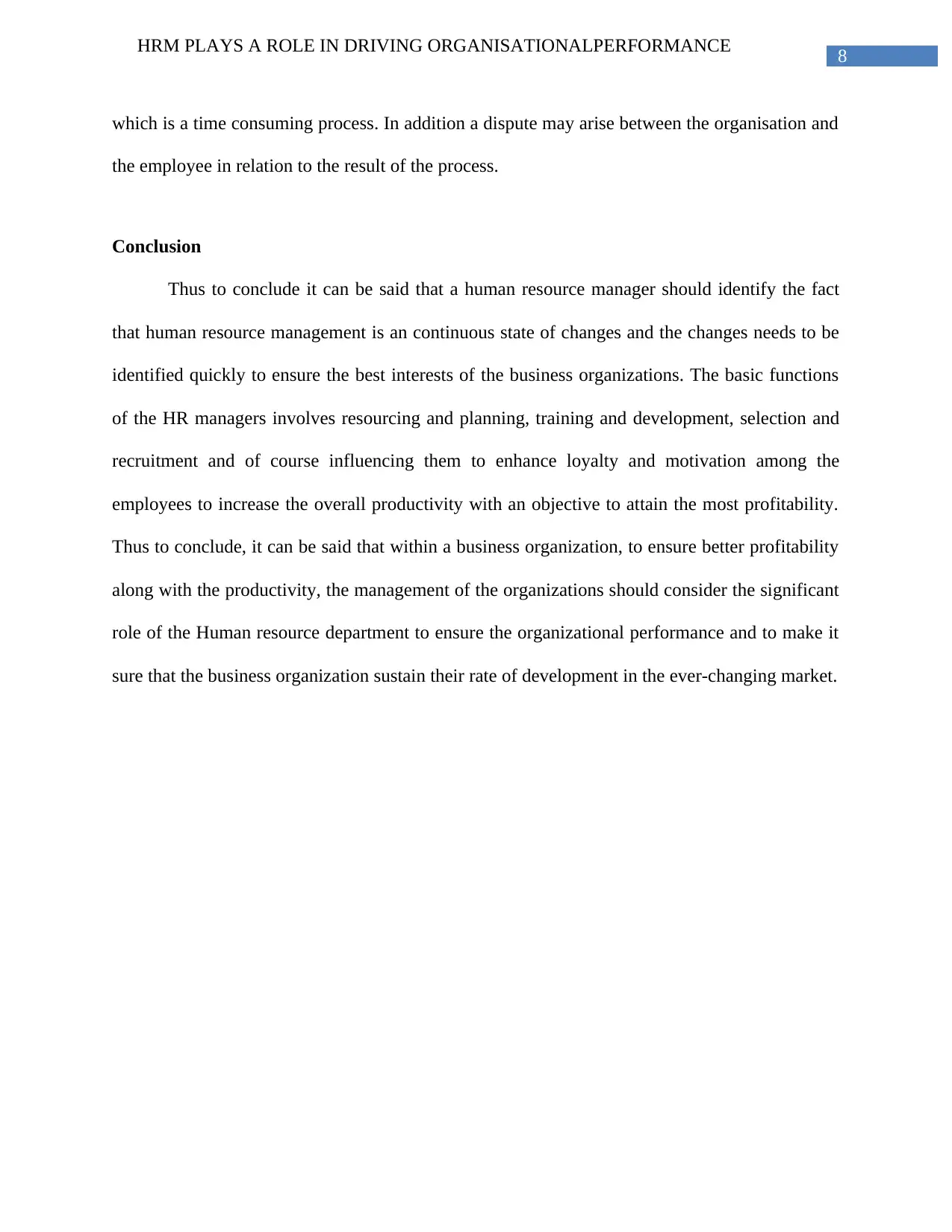
8
HRM PLAYS A ROLE IN DRIVING ORGANISATIONALPERFORMANCE
which is a time consuming process. In addition a dispute may arise between the organisation and
the employee in relation to the result of the process.
Conclusion
Thus to conclude it can be said that a human resource manager should identify the fact
that human resource management is an continuous state of changes and the changes needs to be
identified quickly to ensure the best interests of the business organizations. The basic functions
of the HR managers involves resourcing and planning, training and development, selection and
recruitment and of course influencing them to enhance loyalty and motivation among the
employees to increase the overall productivity with an objective to attain the most profitability.
Thus to conclude, it can be said that within a business organization, to ensure better profitability
along with the productivity, the management of the organizations should consider the significant
role of the Human resource department to ensure the organizational performance and to make it
sure that the business organization sustain their rate of development in the ever-changing market.
HRM PLAYS A ROLE IN DRIVING ORGANISATIONALPERFORMANCE
which is a time consuming process. In addition a dispute may arise between the organisation and
the employee in relation to the result of the process.
Conclusion
Thus to conclude it can be said that a human resource manager should identify the fact
that human resource management is an continuous state of changes and the changes needs to be
identified quickly to ensure the best interests of the business organizations. The basic functions
of the HR managers involves resourcing and planning, training and development, selection and
recruitment and of course influencing them to enhance loyalty and motivation among the
employees to increase the overall productivity with an objective to attain the most profitability.
Thus to conclude, it can be said that within a business organization, to ensure better profitability
along with the productivity, the management of the organizations should consider the significant
role of the Human resource department to ensure the organizational performance and to make it
sure that the business organization sustain their rate of development in the ever-changing market.
⊘ This is a preview!⊘
Do you want full access?
Subscribe today to unlock all pages.

Trusted by 1+ million students worldwide
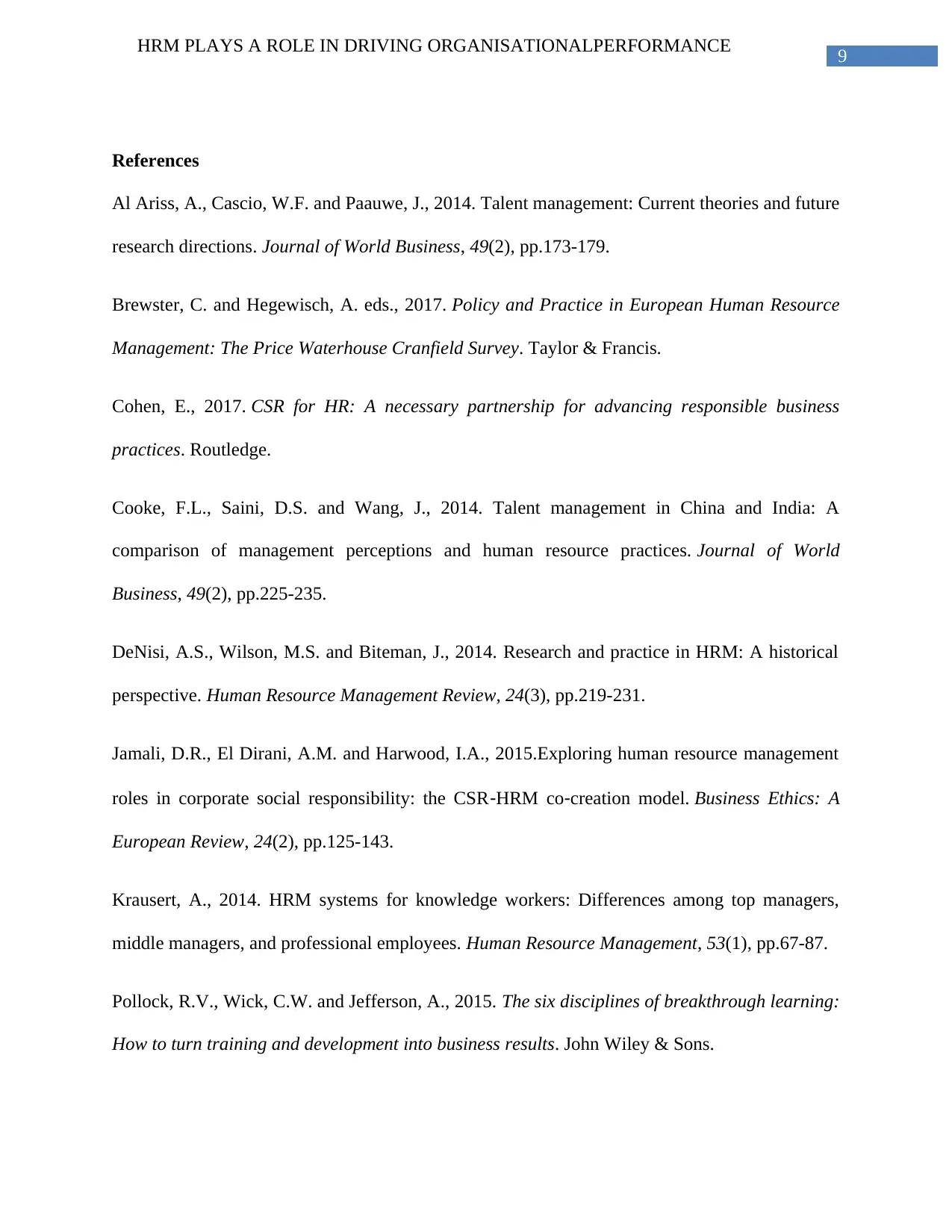
9
HRM PLAYS A ROLE IN DRIVING ORGANISATIONALPERFORMANCE
References
Al Ariss, A., Cascio, W.F. and Paauwe, J., 2014. Talent management: Current theories and future
research directions. Journal of World Business, 49(2), pp.173-179.
Brewster, C. and Hegewisch, A. eds., 2017. Policy and Practice in European Human Resource
Management: The Price Waterhouse Cranfield Survey. Taylor & Francis.
Cohen, E., 2017. CSR for HR: A necessary partnership for advancing responsible business
practices. Routledge.
Cooke, F.L., Saini, D.S. and Wang, J., 2014. Talent management in China and India: A
comparison of management perceptions and human resource practices. Journal of World
Business, 49(2), pp.225-235.
DeNisi, A.S., Wilson, M.S. and Biteman, J., 2014. Research and practice in HRM: A historical
perspective. Human Resource Management Review, 24(3), pp.219-231.
Jamali, D.R., El Dirani, A.M. and Harwood, I.A., 2015.Exploring human resource management
roles in corporate social responsibility: the CSR‐HRM co‐creation model. Business Ethics: A
European Review, 24(2), pp.125-143.
Krausert, A., 2014. HRM systems for knowledge workers: Differences among top managers,
middle managers, and professional employees. Human Resource Management, 53(1), pp.67-87.
Pollock, R.V., Wick, C.W. and Jefferson, A., 2015. The six disciplines of breakthrough learning:
How to turn training and development into business results. John Wiley & Sons.
HRM PLAYS A ROLE IN DRIVING ORGANISATIONALPERFORMANCE
References
Al Ariss, A., Cascio, W.F. and Paauwe, J., 2014. Talent management: Current theories and future
research directions. Journal of World Business, 49(2), pp.173-179.
Brewster, C. and Hegewisch, A. eds., 2017. Policy and Practice in European Human Resource
Management: The Price Waterhouse Cranfield Survey. Taylor & Francis.
Cohen, E., 2017. CSR for HR: A necessary partnership for advancing responsible business
practices. Routledge.
Cooke, F.L., Saini, D.S. and Wang, J., 2014. Talent management in China and India: A
comparison of management perceptions and human resource practices. Journal of World
Business, 49(2), pp.225-235.
DeNisi, A.S., Wilson, M.S. and Biteman, J., 2014. Research and practice in HRM: A historical
perspective. Human Resource Management Review, 24(3), pp.219-231.
Jamali, D.R., El Dirani, A.M. and Harwood, I.A., 2015.Exploring human resource management
roles in corporate social responsibility: the CSR‐HRM co‐creation model. Business Ethics: A
European Review, 24(2), pp.125-143.
Krausert, A., 2014. HRM systems for knowledge workers: Differences among top managers,
middle managers, and professional employees. Human Resource Management, 53(1), pp.67-87.
Pollock, R.V., Wick, C.W. and Jefferson, A., 2015. The six disciplines of breakthrough learning:
How to turn training and development into business results. John Wiley & Sons.
Paraphrase This Document
Need a fresh take? Get an instant paraphrase of this document with our AI Paraphraser
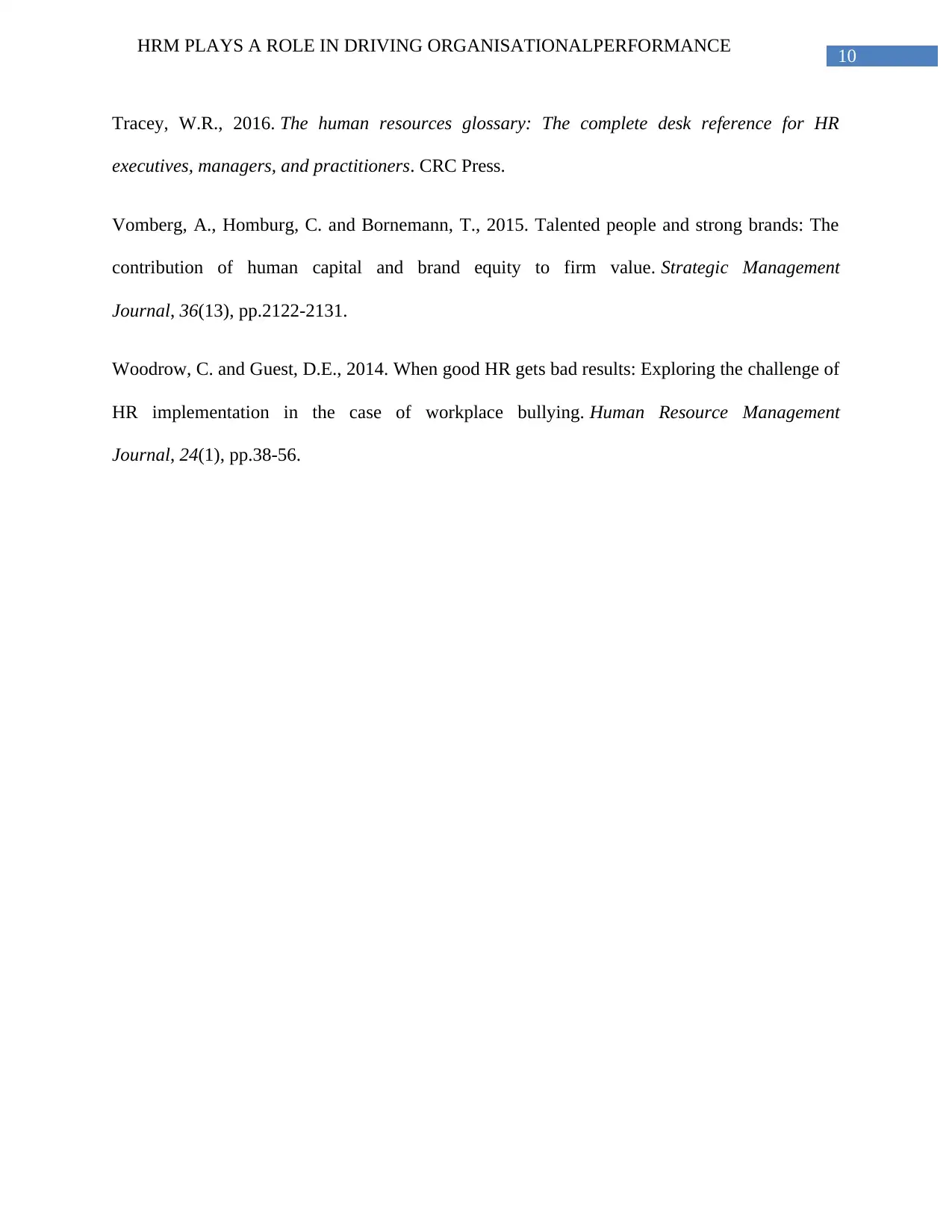
10
HRM PLAYS A ROLE IN DRIVING ORGANISATIONALPERFORMANCE
Tracey, W.R., 2016. The human resources glossary: The complete desk reference for HR
executives, managers, and practitioners. CRC Press.
Vomberg, A., Homburg, C. and Bornemann, T., 2015. Talented people and strong brands: The
contribution of human capital and brand equity to firm value. Strategic Management
Journal, 36(13), pp.2122-2131.
Woodrow, C. and Guest, D.E., 2014. When good HR gets bad results: Exploring the challenge of
HR implementation in the case of workplace bullying. Human Resource Management
Journal, 24(1), pp.38-56.
HRM PLAYS A ROLE IN DRIVING ORGANISATIONALPERFORMANCE
Tracey, W.R., 2016. The human resources glossary: The complete desk reference for HR
executives, managers, and practitioners. CRC Press.
Vomberg, A., Homburg, C. and Bornemann, T., 2015. Talented people and strong brands: The
contribution of human capital and brand equity to firm value. Strategic Management
Journal, 36(13), pp.2122-2131.
Woodrow, C. and Guest, D.E., 2014. When good HR gets bad results: Exploring the challenge of
HR implementation in the case of workplace bullying. Human Resource Management
Journal, 24(1), pp.38-56.
1 out of 11
Related Documents
Your All-in-One AI-Powered Toolkit for Academic Success.
+13062052269
info@desklib.com
Available 24*7 on WhatsApp / Email
![[object Object]](/_next/static/media/star-bottom.7253800d.svg)
Unlock your academic potential
Copyright © 2020–2025 A2Z Services. All Rights Reserved. Developed and managed by ZUCOL.





